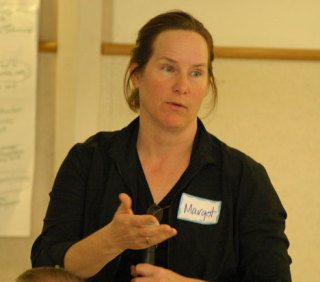South Whidbey School District officials expected about
60 folks at a community forum held Saturday morning at the high school.
What they got was more 100 parents — most concerned about potential teacher layoffs and the wider issue of a $1.9 million budget shortfall — a number well beyond the typical crowd of 35 at such forums.
The sixth annual forum was geared to the questions of further school consolidation, start times for the public schools and the use of technology to improve student achievement.
But the 800-pound gorilla in the room, of course, was the recent news that 37 certificated teachers and counselors had been notified they were in jeopardy of losing their jobs.
The final reduction-in-force notices (RIFs) will be sent no later than May 15, according to the teachers’ union collective bargaining agreement. The district has said the actual number released will be smaller.
When I saw the list, I cried,” said Lisa Hanna. “We need to focus on the bottom line here. (Special education teacher) Jennifer Gandarias made all the difference in the world to my son and she’s on the list. Mark Eager, David Nelson; this is insane.”
Rich Bacigalupi from Langley warned district leaders that people are angry.
“If good teachers are let go, I’m out of here,” he said. “I want the public system to work.”
And Terry Swanson asked for a list showing the rankings and date of hire for those on the list, since seniority was the prime reason for inclusion.
“I’d also like to see the budgets of individual programs; which are being cut and which are still available,” Swanson said.
School District Superintendent Fred McCarthy gave a presentation on cumulative downward enrollment trends, the recession’s impact on programs, the state’s $9 billion budget deficit and the resultant economic realities for South Whidbey.
McCarthy told the audience that the district’s budget shortfall remains close to $1.9 million for the next school year. Officials have cut $600,000 from that figure through reductions in programs, curriculum and operating efficiencies. That leaves $1.3 million in salaries and benefits to make up.
The district’s total budget for this school year is $17 million.
He noted that the district is a third smaller than it was 10 years ago, and the challenge was to bring costs into line with declining revenues. McCarthy said that some names are on the list because of seniority, and others because programs are being whittled down to meet the financial needs of the school district.
McCarthy added that he feels the pain any layoffs might cause.
“In 1976, my wife was RIF’d and her picture was on the front page of the Everett Herald,” he recalled. “It wasn’t a happy time then, and it isn’t now.”
Attendees then convened around tables to examine if more schools should be consolidated as a budget-cutting measure. This summer, the primary school is shutting down — at an annual savings of $250,000 — and operations moved to the newly-formed South Whidbey Elementary School next door.
The results of their discussions were posted around the room.
Over the past several years, the district has explored closing the middle school, then selling or leasing the valuable 23-acre property near downtown Langley. The two-story 95,000-square-foot structure is the oldest in the district’s inventory, built in 1935.
“The middle school is inefficient and should be moved,” one participant noted.
Others agreed that consolidation of the middle school students into the high school would be a start, believing that it’s appropriately designed to keep middle and high school students separate as needed, and closure of the middle school would reduce operating costs significantly and permanently.
But there has been opposition from those who want to keep the kids close to town and others who point out that replacing the classrooms might cost more than upgrading the school. And some citizens are worried about having older and younger children in close proximity.
Other comments targeted efforts to bring more families with school-age kids onto the island, even moving the Bayview School to the high school.
The facilitator at one table, elementary school principal Scott Mauk, said that it was important that parents share leadership in dealing with challenges.
“Just by being here, you know a lot more,” Mauk said.
Parents also argued the pros and cons of a single start time for all schools, perhaps 9 a.m. to 3 p.m. This would allow a single bus run, saving fuel and personnel costs, but there is no hard data yet on the financial impact.
Some felt this would be major hardship for drivers, who would see their hours drop.
Driver Chris Cook agreed.
“If you cut my hours down, I’ll have to leave and I won’t be alone,” Cook said.
One parent was adamant, saying she wouldn’t allow her grade-school youngster to ride on the same bus as high school students. Another said the plan was impractical with two widely-separated secondary school sites.
As the session ended, parent John Knox asked the school board and administrators to continue seeking a financial solution.
“We think this is a great school district,” he said.
The next school board workshop is 6:30 p.m. Wednesday, May 6 at the intermediate school on Maxwelton Road in Langley.



